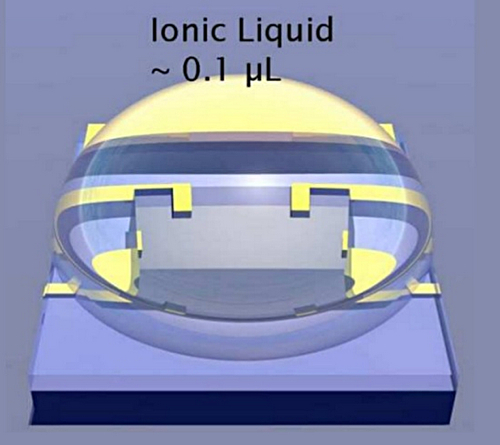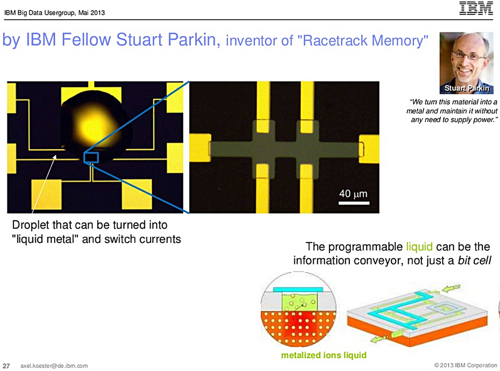This article is more than 1 year old
IBM shows off phase-shift LIQUID METAL storage tech
So this other guy – he's a Terminator like you, right?
IBM Edge 2014 Attendees at last week's IBM's Edge 2014 conference in Las Vegas heard all about liquid metal storage. But don't think of Terminator 2-style shape shifting – think state shifting instead.
Yes, really. It was a bit of a throw-away as it was the last bullet point in a list of storage futures presented by IBM chief storage technology man in Europe, Dr Alex Koester, but exciting nonetheless. We non-attendees get to hear about it courtesy of IBM Master inventor Tony Pearson's blog.
Dr Koester works closely with IBM Research and described some of the projects they are working on:
- 120PB file system solution that involved a grid of IBM POWER 775 servers. Instead of traditional RAID, the system used GPFS Native Raid, which offers an 8+3 Reed Solomon protection scheme.
- Multi-cloud storage that allows you to access storage from multiple public providers without having the bottleneck of a single master scheduler.
- Phase Change RAM (PCRAM) which does not rely on capturing an electrical charge. This will be 12x faster than PCIe Flash, and 275x faster than consumer SSD.
- Liquid state storage. Rather than solid state, metal is kept in its liquid state to store binary information.
The liquid metal idea caught our eye. We found out that, in March 2013, IBM announced a liquid-based transistor that it claimed processes data like the human brain.

IBM liquid transistor
Another slide in the deck used the "liquid metal" term, with reference to programmability and mentioned a metalised ions liquid.
Big Blue says two black-and-gold items on the slide show an:
optical image of a typical ionic liquid (IL) gated device with a droplet of IL on top of the gate electrode and the oxide channel. The gold squares are pads used to make contact to the device via wire-bonding. On right is the magnified image of the device showing the channel (brownish yellow) and the gold electrical contacts (bright yellow). The contacts on the right and left of the channel are the source and drain contacts. The four other contact are used for 4-wire resistance and Hall measurements.
An ionic liquid is a salt in a liquid state, a "melted" salt, and some salts melt at room temperature or below it.
Salts are ionic compounds produced by a neutralisation reaction between an acid and a base. An ionic compound is (this is getting recursive - Ed) a chemical compound with ions bound together in a lattice structure by ionic bonds, electrostatic attraction between positive and negative ions. Such ions are atoms or molecules in which the number of protons and electrons are dissimilar, giving the thing a positive or negative charge.
An example of a salt is ... wait for it .... salt, sodium chloride.
The term "liquid metal" is a bit misleading as we shouldn't think of a mercury-like substance, a true liquid metal. Instead it is an ionic liquid, a positively charged ionic liquid electrolyte. The boffins applied it to vanadium dioxide, an insulating material, and converted it to a metallic state.
It remained in the state until a negatively charged ionic liquid electrolyte was applied to it, making it non-conductive again.
What Big Blue's boffinry has found is a means of making chips work using tiny ionic currents (streams of charged atoms). We're told that they can "reversibly transform metal oxides between insulating and conductive states by the insertion and removal of oxygen ions driven by electric fields at oxide-liquid interfaces."
The oxides here are intrinsically insulating. Stuff oxygen ions in them and they become conductive and are stable and non-volatile, maintaining the state when electrical power is switched off. Take the oxygen ions away and they become stable insulators again. So we have a new way of storing data.
IBM Fellow Dr Stuart Parkin – who helped invent race-track memory technology – says of this ionic liquid idea: "Going beyond today’s charge-based devices to those that use miniscule ionic currents to reversibly control the state of matter has the potential for new types of mobile devices. Using these devices and concepts in novel three-dimensional architectures could prevent the information technology industry from hitting a technology brick wall.”
Hmmm. There aren't any racetrack memory devices around so we are left thinking this is another, highly technical example of IBM research boffinry.
The idea is that you say "Gee whiz!", are very impressed and promptly buy a Storwize V7000 or IBM cloud service. ®

